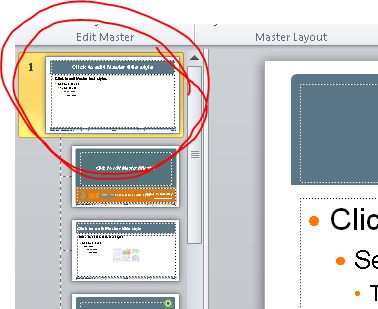

For example, if you wanted to add a logo to the bottom of all your slides, this would be the place to add that logo. You would use the master slide to make changes to all the different types of slides at one time. Making Changes in Slide MasterĪny changes to layout or formatting in the top-level master slide will be changed in all the slides in your presentation. By default, Slide Master will open up to the type of slide you were on when you opened it. At the top level of this outline is the master slide. Once you’ve opened up Slide Master, on the left-hand side of the screen you can see thumbnails for the different types of layouts, such as title, comparison slides, image, and others. Second Way: Shift – Normal View button (see bottom right of the screen).First Way: Navigate to the View ribbon and then click on Slide Master.There are two ways to access Slide Master: You can also rearrange or resize the default placeholders that hold titles, text, or other media. Another key aspect of Slide Master is the ability to format and adjust the placement of the slide number, date, and footer text for your slides. You can also add things like the company or organizational logos to your slides, or perhaps a watermark for the background. You can change fonts, font sizes, font colors, and colors. Slide Master allows you to make changes to the formatting and layout of the slides in your presentation. Reading view: This view includes animations and transitions, without switching to full-screen mode.Do you find yourself making a lot of formatting changes to your slideshows? Do you have to constantly rearrange the placeholders in each slide so things look the way you feel they should? Do the color options never seem to match what you need? Would you like to add a company logo or watermark? Then it’s time to look into PowerPoint’s Slide Master tool.In this view, PowerPoint creates a preview of what a print-out of slides looks like using notes. Notes page: In normal view, it’s possible to add notes to your slides.Easily organize your content in this view with just a few clicks. Slide sorter: This view offers an overview of your slides and information on transitions and their duration.

Outline view: In this view, you can structure your presentation around an outline in PowerPoint and can easily optimize your content in this way.In normal viewing mode, you can work on individual slides and navigate via the miniature slides pane. Normal: The view that’s automatically selected when you start PowerPoint.

Below you’ll find an overview of the different viewing options and their benefits. However, PowerPoint offers a host of different viewing options to choose from that can be used interchangeably.

When you launch PowerPoint and open a presentation, “ normal view” is automatically activated.


 0 kommentar(er)
0 kommentar(er)
